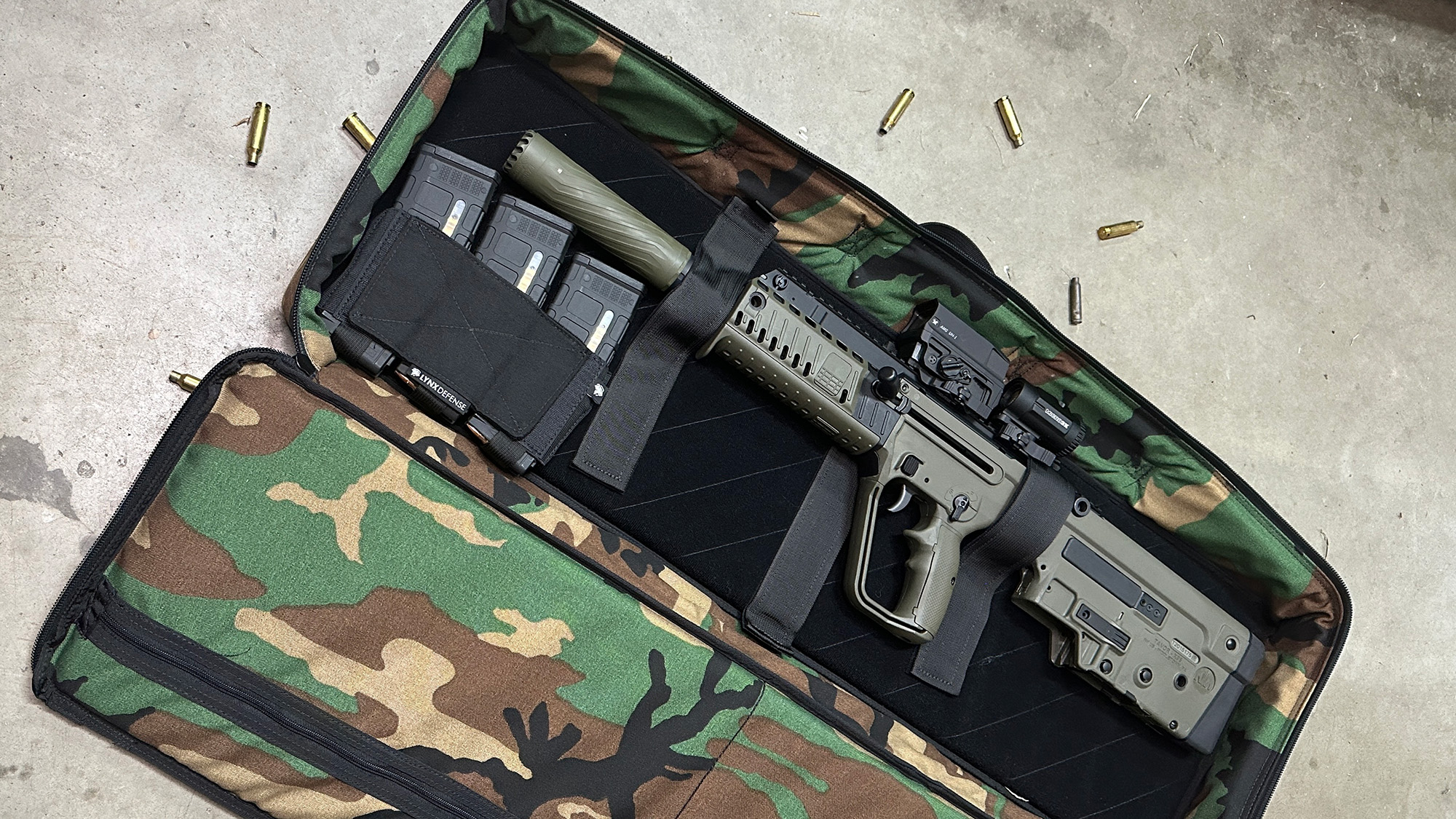
Ready to see what we have coming?
Lynx Defense will release some new things soon. Let us deliver them right to your inbox!

Lynx Defense will release some new things soon. Let us deliver them right to your inbox!
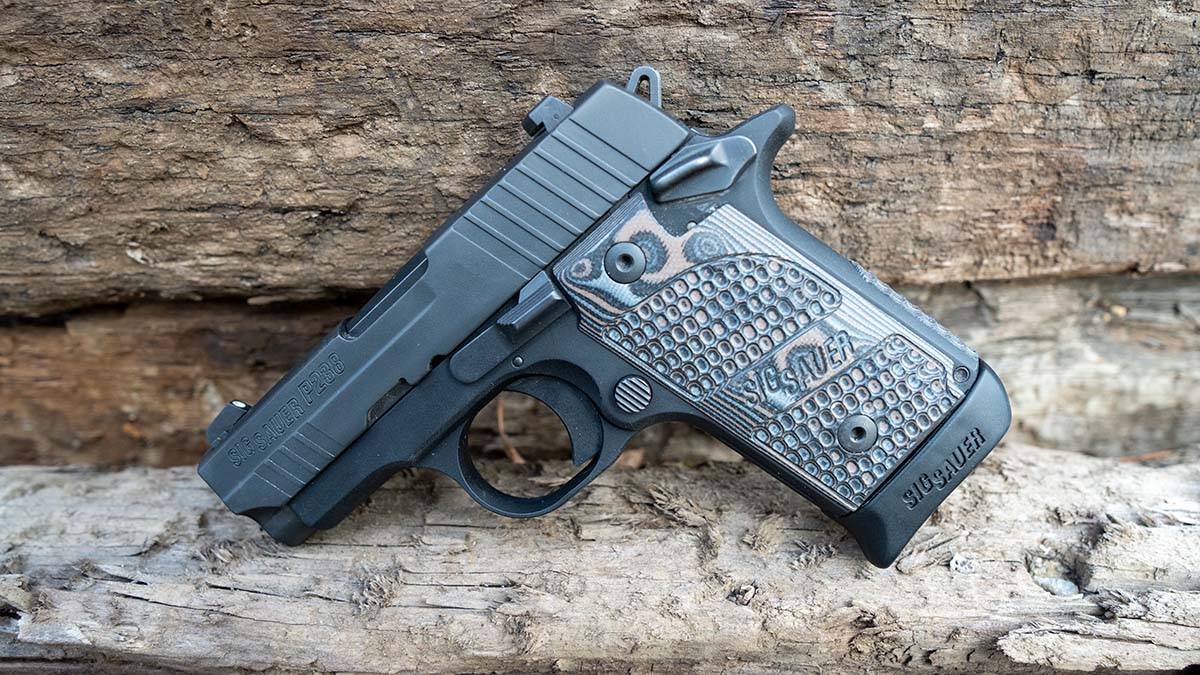
We may earn revenue from product links on this page and participate in affiliate programs. Learn More ›
The Sig P238 is the kid brother to the Sig P938, in this review we’ll find out if it can hold its own in a fight. Now let us dive into the Sig P9238 and see how it compares in the small 1911 world!
There are literally volumes of books filled with the history of Sig Sauer.
The roots of SIG started out in 1853 as a wagon factory built near the Rhine Falls in Switzerland.
Just a few seemingly short years later they would manufacture thousands of muzzleloading rifles after a challenge by the Swiss Federal Ministry of Defense.
“In part to a challenge from Switzerland’s Federal Ministry of Defense, the Swiss Wagon Factory entered the competition to develop a state-of-the-art rifle with the hopes the Swiss Army would adopt it.”
“In 1864, the award went to the Swiss Wagon Factory for its Prelaz-Burnand rifle.
At this point, the Swiss Wagon Factory, with an order for 30,000 muzzleloading Prelaz-Burnand rifles in hand, changed the name of the company to the Swiss Industrial Company – Schweizerische Industrie-Gesellschaft, known worldwide as SIG.
Fast-forward to the 20th century. In 1949, the SIG P49, the forerunner of the SIG P210, was developed for the Swiss Army and destined to become a legend on the battlefield as well as the competition field.
That same year, the P220 made its appearance as the new pistol for the army, soon followed by the compact P230 for the Swiss police. These pistols offered new features and levels of reliability never before seen in the industry.
By the 1970s, SIG’s small arms division was expanding to include Hämmerli Target Arms from Lenzburg, Switzerland, and J.P. Sauer & Sohn, GmbH, of Eckernförde, West Germany, known worldwide for their hunting rifles.
In the 1980s, SIG set its sights on the United States of America. The American market was a vital part of SIG’s business plan to continue to expand its market share and become an international leader in the small arms industry.”
You can check out SIG’s full history.
The Mid 1980’s saw SIGARMSⓇ established to import their own products into the US. These products included the P220, P230 and P226 among others.
Fast forward to 2007 and SIG changed their name from SIGARMS to SIG SAUER. This is still the name that they use today. In 2015 SIG expanded to include offerings in suppressors, optics, ammo, and even airguns.
One of the key features of the SIG P238 is its diminutive size. The P238 is an extremely compact handgun. Some people even pocket carry the P238.
If this is your mode of carry, I would suggest you use a quality holster that provides full coverage of the trigger and keeps all objects out of the trigger guard.
Another key feature of the P238 is its classic design. The P238 borrows heavily on the design of the Springfield 1911.
It so closely resembles a 1911, that it looks like it was hit with Wayne Szalinski’s Shrinking Machine from Disney’s “Honey I Shrunk the Kids”. Obviously, these looks are only skin deep as there is no way a .45 ACP could fit in this tiny frame.
Speaking on calibers, the P238 is chambered in another one of J.M. Browning’s popular chamberings; the .380 Automatic Colt Pistol or ACP for short.
This smaller caliber is very popular in the American market for smaller framed semi-automatic pistols.
The grips on the SIG P238 are thin, just like the rest of this gun. There are two panels on the P238 just like on the 1911.
Depending on which model of the P238 you select will determine what the grips are made of. This particular model sports G10 panels that have an aggressive texture to keep the pistol firmly in your hand.
For those who are not familiar, G10 is a high-pressure fiberglass laminate that is created by stacking layers of fiberglass soaked in resin and then baking in heat and pressure until the resin sets and you are left with a hard, lightweight material.
Even though the grips are thin, they fit in the hand nicely and in conjunction with the G10 grips, the P238 doesn’t feel like it’s going anywhere when shooting.
The angle of the P238 grips feels good and doesn’t strain the wrist like some other manufacturers seem to do.
Like on the 1911, the P238 has a beavertail to help the shooter’s hand be protected from hammer bite.
Without this feature, the meaty portion of your hand would be subject to being pinched and causing bruises or broken skin.
As stated previously, the texturing found on the grip of the SIG P238 can vary between which sub-model you choose.
The model that I have is aggressively textured on the side grip panels, and in addition to this, there is also an insert into the lower portion of the backstrap.
In addition to these enhanced grip areas, the SIG boasts vertical striations located on the front strap to help control the overall handling of the small framed gun.
While subtle, this is a welcome alternate approach as I believe the aggressive stippling found on the backstrap and grip panels would be too much in this location.
One area where SIG SAUER really shines (lol) is in the night sight department. SIG offers virtually all of their pistols with an option for night sights from the factory.
Other brands that will not be named, cough-Glock-cough, ship their pistols with cheap polymer sights that the end-user has to swap out on their own.

While this does leave the aftermarket wide open, I believe offering a high-quality, OEM part is more desirable in this case.
SIG has done this again with the P238. The sights located on the slide are steel, and contain three tritium vials that light up when in the dark. The vials are surrounded by white plastic so the sights are also easily seen during the day.
I found that the squared-off sight post offers the perfect amount of space to make accurate shots but also doesn’t clutter up the view of the target.
This is an important thing to keep in mind for a self defense/concealed carry pistol.
The controls on the SIG P238 are almost a copy & paste of the classic 1911 design.
One thing you might find missing is the grip safety. I have never been a fan of this type of safety, but I also haven’t let its presence keep me from owning pistols that sport it.
The P238 is a single action only or SAO design. This design typically has an external hammer.

The P238 does just that. The hammer is located at the back of the slide and is skeletonized. The hammer has horizontal ridges cut across it to assist in manipulation.
While the P238 lacks a grip safety, it does carry over the safety located on the side of the frame.
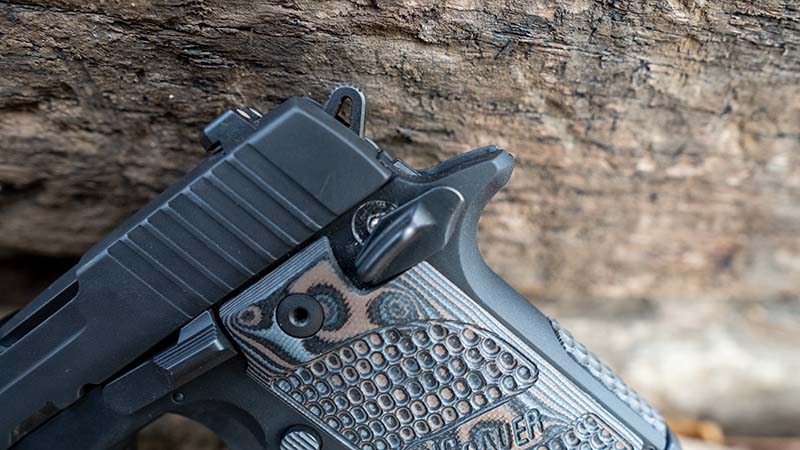
There are some differences between this safety and the one found on a 1911. Instead of physically locking with the slide on the exterior of the slide, it moves a small plunger on the side of the frame and this blocks the hammer from falling.
Because of this divergence from the traditional 1911 style safety, the slide can be manipulated while the gun is on safe.
This means that you can unload the chamber and still have the safety activated. This is a big plus in my book.
The slide stop is in a familiar place and functions just as it would on a full size 1911.

The slide stop is located in a position on the frame where it is easily reachable by the thumb when the gun is held in a shooting grip. The slide stop is only located on the left side of the frame.
The slide stop can also be used as a slide release on the P238. The angle and texture located on the pad of the slide stop make it easy to manipulate.
The slide stop also doubles as the take-down lever on the SIG P238. This works in the same way as a 1911. You must first remove the mag and make the gun clear.
Next, you pull the slide back until the slide release can be pushed across from right to left and then removed. Once removed the slide will freely move forward and come off the guide rails.
Reassembly is a little more tricky as the ejector is spring-loaded and once the slide is removed it will push up and the rear of the slide will not move past it on its own. You must push the ejector down so that the slide will move past it on its way back.
After you have the slide reinstalled, you must pull it back so the pin can be reinserted through the frame and barrel. This can be tricky and if you aren’t careful you can end up with an “idiot scratch” on your frame.
Also in a familiar location is the magazine release. It sports a checkered texture and is easy to actuate.

The mag release is located on the left side of the firearm, and is not reversible. It is made of metal and is of average size.
The magazines of the P238 are constructed of quality stainless steel. They are easy to insert into the frame of the firearm even though there is no mag well flare to speak of.
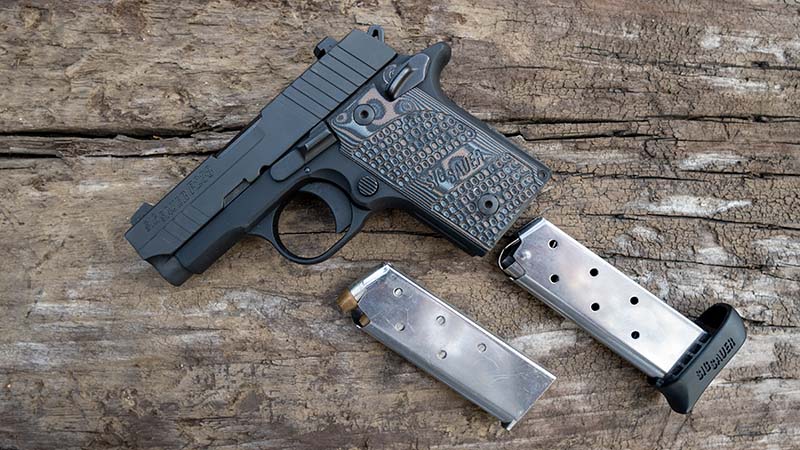
When seated the lock up emits an audible click and you also get tactile feedback that the magazine has been locked in.
When you drop a magazine it falls free of the firearm smoothly and without catching up.
The only observation I have in this area is to make sure you keep your pinky finger free from the area so as to not impede the drop of the mag. This same thing can be said of any compact or subcompact firearm.
Surprisingly, the trigger on the SIG P238 is made from polymer. This is an interesting divergence from the otherwise high quality parts located on this handgun.
Even though the trigger is made from something other than metal, it doesn’t mean that it’s horrible. You just look at almost any other modern handgun in today’s market to see that a polymer trigger is satisfactory at worst.
The trigger face on the P238 has vertical ridges that I personally don’t care for.
I prefer a smooth trigger face like that found on the Kahr PM9. The trigger feels good enough and is serviceable for a self defence pistol.
The SIG P238 follows suit with its larger cousin the 1911 in the action department.
A single-action firearm is one where the trigger does just one job; release the hammer.
There is no long, super heavy, or gritty trigger pull here. The advertised trigger pull weight is somewhere around 6-7 pounds. This is pretty standard for a self-defense firearm.
As a major manufacturer of firearms, SIG has several companies that offer accessories for their most popular handguns.
The P238 is no different. You can find grip panels made of practically any type of material imaginable on Amazon.com or even a laser on Brownells.com. Sig themselves also offer select accessories for most of their firearms.
If you’re like most people who buy a micro compact for concealed carry, you will instantly begin searching for a holster once you have made your gun purchase.
As this Sig P238 wasn’t necessarily purchased for me to carry, but for my wife, the search looked a bit different.
She already had a dedicated ccw purse that she had previously carried the Walther PK380 in, and I had recently purchased her a cancan concealment Hip Hugger Classic holster that she enjoyed using quite a lot.
Some time went by, and one day I decided to try out the little Sig. Digging through my stack of gun boxes, I found the Sig P238 box and fished out the included OWB plastic holster. I slid the Sig down into it and clipped it to my belt.
Bleh.
It instantly felt cheap and clunky for such a small pistol. As I was in a hurry and was walking out the door, I took it off and flipped it around and placed it into my waistband on the left hand side of my body in a cross-draw manner.
I do not advocate carrying in this manner as it is not very efficient and requires you to reach across your body to draw your pistol should you need it.
It can also come with some safety concerns as you may end up flagging someone you do not intend to point the gun at when drawing your pistol.
It was at this point I knew the search was on for a quality, but budget minded holster for when I wanted to take the mini 1911 like Sig for a spin.
Like the Walther PPK/S, when Michael suggested WTP Holsters, I knew I had found the solution I had been looking for.
The IWB holster from WTP allowed me to carry discreetly, and comfortably all while keeping my hard earned cash.
It’s here where those that love the classic 1911 could find some fault with SIG’s mini 1911, but for the most part, the form and function of the P238 are true to its larger cousin.
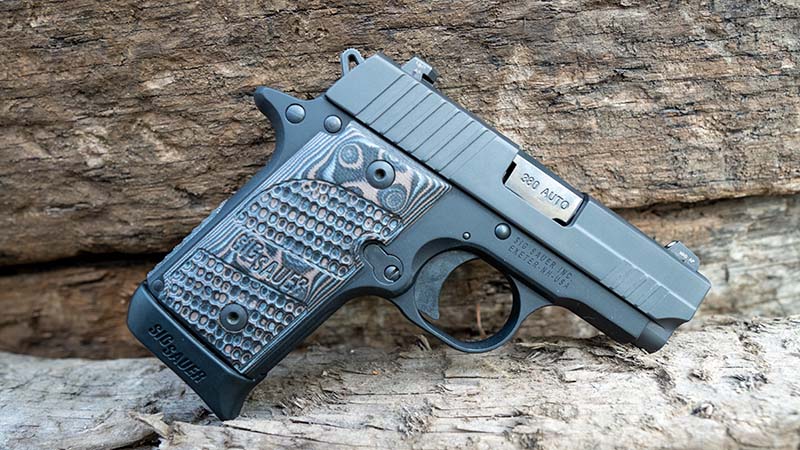
SIG has taken some liberties with the design features and this also applies to the overall aesthetic of the firearm.
I find the miniaturized P238 to be a handsome design that follows the form of a full size 1911 when possible but also offers practical updates like forward slide serrations and a nicer extended magazine floor plate along with upgrades in the front and backstrap of the handle.
The totality of the updated lines, improved magazine floor plates, the G10 grips and inserts along with the crisp roll marks and deep bluing found on the SIG P238 make it a sharp-looking firearm in the hand.
As a 1911 style firearm, there are some observations that can be made about both the full and pint-sized counterparts.
Both of them feel hefty and solid in hand. This weight helps both with perceived recoil.

The .380 can be quite snappy when packed into a small frame. I found this not to be the case for the P238.
The recoil was noticeable, but not more than expected. Follow-up shots were quick and the sights were easy to keep track of while shooting.
Overall the P238 is fun to shoot.
My husband asked me to write about why I chose this gun for my concealed carry weapon.
At the time of purchase, there were not a lot of options for a small, thin concealable (on a small woman’s frame) handgun with a manual safety.
I have had this weapon for about 7 years so the ability to use it and practice with it as often as I can has made me feel confident in my ability to carry it concealed and manipulate the safety under duress.
There are a lot of things that I like about the P238. I like that it has a manual safety and that the safety is in an ideal position for my thumb to actuate it while keeping a shooting grip on the firearm.
The manual safety was a big point for me because with two little kids I wanted to make sure when I carried it I knew the safety was on so there would be an added layer of protection, God forbid if they should get their hands on it.
I like the texturing on the grip panels because I feel like I have a good hold of it when I have it in my hand.
I like that it has a beavertail to protect the soft tissue in my hand from slide bite.
When shooting, I like the visibility of the SIG sights and I especially like the tritium in the night sights that make it glow in the dark.
I also like that it has a single-action trigger; it is really easy for me to pull and make accurate shots. I can rack the slide easily and load the chamber all with the safety engaged.
It is chambered in a small caliber, .380 ACP, which is more manageable in recoil when I shoot, which is very helpful.
I do like the extended magazine because it gives a place for my pinky to sit. I know that is the point, but it makes my grip better and I feel more in control.
The added round of ammunition is a bonus to me. I also like that the mag release is on that side so I can change magazines easily if needed.
One of the top reasons I chose this as my concealed carry weapon is because it is easy to conceal.
I use a Can-Can Concealment belly band when I walk (run before I had the twins), which allows me to carry it in the small of my back or in my appendix area in front of my hip while wearing leggings or other non belted workout clothing.
This method can also be used when wearing any other type of clothing and keeps the P238 close and tight to my body. The P238 came with a plastic holster that can get you by in a pinch.
I also have a few concealed carry purses but know that this is not an ideal or secure method of carrying.
-Mrs. M.
The SIG P238 continues SIG Sauer’s fine pedigree of handguns. The quality and attention to detail in design and craftsmanship is second to few. This was Sig’s goto compact before the Sig P365 and P365XL were made.
If you are already familiar with the operation of a 1911 you will feel quite at home carrying a P238.

If you aren’t familiar with the 1911’s operation then I would suggest you put some reps in and send some ammo downrange to make yourself so before you rely on the SIG P238 or any firearm with an external safety for that matter.
Overall, the SIG P238 is a quality option for concealed carry and as long as you do your part, it will do just fine in that role.
Almost all modern firearms can be dry fired, but you can purchase snap caps to help if you are concerned about possible damage.
No. The overall selection of sub-models that were around in the early 2010s has been shrunk, however.
Depends. Do you feel comfortable with an exterior safety on your firearm? Do you feel confident with operating a single action trigger? If you train with your firearm and get enough reps in, you should be just fine.
Want to check out more .380 ACP pistols? Check out the Walther PPk/s or the Walther PK380.
My wife and I have carried concealed for some 30 years, and over the decades have carried a variety of handguns, from P230 to (gasp) Megastar (stoked with .45 Super) and LCRx to (gasp) 629 Mountain Gun. But as age (we are both in our 70s) has become a factor, our hands not having the strength they once had, we’ve both found that DA triggers and stiff slides have become more and more of a challenge. About six years ago the wife, while then carrying a P230, decided she wanted something a bit more manageable, so off to our friendly local dealer we went. It didn’t take long for her to fall in love with the P238. Simple, compact, lightweight, SA trigger and very manageable mainspring. She purse carries, prefers the slightly heavier steel frame over the alloy, and likes the factory grips and magazine. After shooting hers a few times I also got the bug. I fitted mine with Hogue finger grips, Sig extended magazines (as my hands are somewhat larger than hers), and carry it in a pocket holster in the right front pocket of my cargo pants, with two spare mags in a DeSantis mag pouch in my weak side “cargo” pocket. And for those that are worried about the stopping power of the .380 ACP, remember that modern lightweight high-velocity JHPs are not your grandfather’s .380. And as the Brits like to say, “Any bullet wound is terribly dissuasive.” Finally, I would note that for a compact pocket pistol the P238 is remarkably accurate. At the common self-defense range of 20 feet I can put an entire box of shells into a 4” group. A+